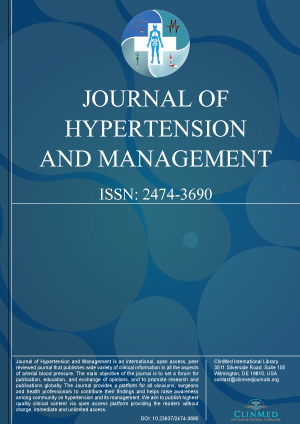Early Online
Open Access DOI:10.23937/2474-3690/1510078
David Aronoff M, Jean Wassenaar W and Meena Madhur
Article Type: Review Article | Indexed Archive: Volume 11
Article Formats
- Full Article
- XML
- EPub Reader
Open Access DOI:10.23937/2474-3690/1510074
Smoking May Not Have a Long Term Effect on Body Weight
Mehmet Rami Helvaci, MD, Yasemin Kayabasi, MD, Atilla Yalcin, Orhan Ekrem Muftuoglu, Abdulrazak Abyad, MD and Lesley Pocock
Article Type: Research Article | Indexed Archive: Volume 9
Article Formats
- Full Article
- XML
- EPub Reader
Open Access DOI:10.23937/2474-3690/1510073
Electronic Diary Monitoring for Hypertension Post Stroke
Minna Levine, OT, PhD, OTR, Ferdinando Buonanno, MD, Ronald Calvanio, PhD, Richard Goldstein, PhD, Jared Jacobson, MPH and MingMing Ning, MD, MMSc
Article Type: Original Article | Indexed Archive: Volume 9
Article Formats
- Full Article
- XML
- EPub Reader
Open Access DOI:10.23937/2474-3690/1510072
Fetiya Oumer, Tesfaye Tolossa and Abebaye Aragaw
Article Type: Original Article | Indexed Archive: Volume 8
Article Formats
- Full Article
- XML
- EPub Reader
Open Access DOI:10.23937/2474-3690/1510070
Isolated Systolic Hypertension in Young Patients
Minetto Julian
Article Type: Review Article | Indexed Archive: Volume 8
Article Formats
- Full Article
- XML
- EPub Reader
Open Access DOI:10.23937/2474-3690/1510069
Assessment of an Ambulatory Blood Pressure Monitoring Protocol in an Academic Outpatient Clinic
Yvette Zeng, Les Covington, Evelyn Sbar, Beverly Lewis, Rodney B Young and Eric MacLaughlin
Article Type: Research Article | Indexed Archive: Volume 8
Article Formats
- Full Article
- XML
- EPub Reader
Open Access DOI:10.23937/2474-3690/1510067
Caffeine Elevates Blood Pressure
Maria Teresa Ambrosini, BS, PharmD, BCPS
Article Type: Commentary | Indexed Archive: Volume 8
Article Formats
- Full Article
- XML
- EPub Reader
Open Access DOI:10.23937/2474-3690/1510066
Obaseki Chigozie Okwudili, Adodo M Samuel, Ede Stephen Sunday and Elvis I Agbonlahor
Article Type: Research Article | Indexed Archive: Volume 8
Article Formats
- Full Article
- XML
- EPub Reader

Volume 8
Issue 1
Issue 1
